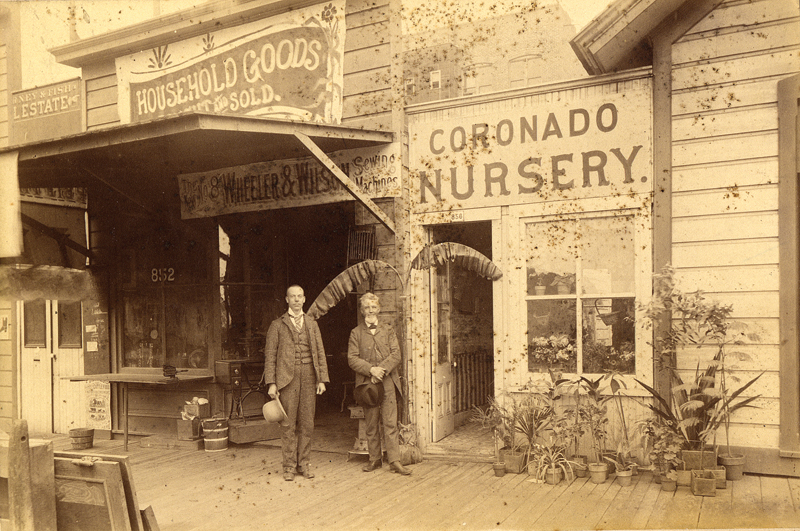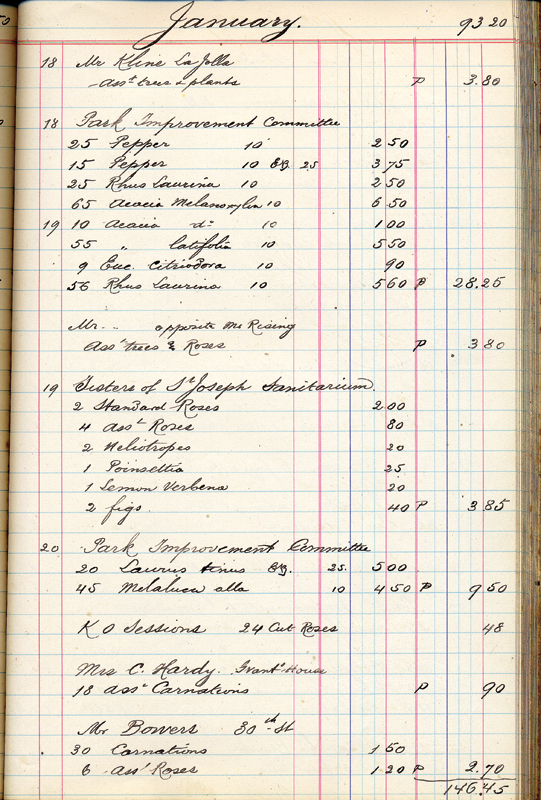|
The Historic Home
Landscape and Gardens
By Alana Coons
The garden often gets the least attention when restoring or renovating the old home. Some just don't know where to start when it comes to historic garden design and others don't see the importance or need. While they may have mastered plaster finishes and matching the tile work in the bathroom, matching the garden to the period the house was built doesn't always get the attention it deserves.

Kate Sessions Coronado Nursery storefront c. 1880's. This rare photograph shows a variety of types of plants used in San Diego homes. Note the unembossed single rimmed terra cotta pots, still available today. Courtesy Coons collection
However, if careful attention is given to your garden it will be transformed just like the rooms inside your home after you have restored and furnished them with the correct period details. By bringing the impression of a period landscape back to your old home you can create a sense of harmony that begins right at the front walk, not just the front door.
The first advice for a homeowner in all respects of working on an old house that stands for the garden as well is to wait a year before making changes. Watch through four seasons to see how your landscape actually works. I know that's hard to do! I have worked on many historic gardens and at first glance the new homeowner sees a tree or shrubs and says, "That's got to go!" But I always counsel to wait and let the landscape tell us its story. What seemingly makes no sense at first may turn out to be an important and integral plant or tree to the design and function of your home.
"I think the question is less what people install at their period house than what they rediscover and save of the real historic garden that is still there, no matter how difficult for modern eyes to see," says Scott Kunst, owner of Old House Gardens, an antique bulb supplier in Ann Arbor, Michigan. "A new garden is always richer, I'd say, when it honors and builds on its past lives."
Take advantage of the four seasons waiting period to document the plants in your garden. Documentation not only provides a record, as it exists at the present time but also will give you a baseline to work from. It is important that you completely survey your property.
There are many ways to document your property. There are informative and easy to use step-by-step type books and numerous computer programs to choose from as well and with digital photography providing such ease of selection and storage of photos, it is the way to go. Ideally you will want to include botanical name or species, common name and size. To ensure full representation of herbaceous plants, remember to take into account your garden in different seasons.
San Diego has always had the great fortune of a climate that allows for all manner and types of plantings. While much was brought here during the Mission period, it was the Victorians, the great plant explorers, who brought to America a palette so vast that even today's selections do not compare with the variety available in the 1880s. In San Diego as early as the 1870s Frank Kimball had U.S. agricultural & horticultural experimental stations set up.

Page from January, 1906 ledger of E. Benard's Mission Valley Nursery. Benard started a large nursery in the valley in the 1880's with thousands of rose cuttings he brought from France. He expanded into olives and ornamentals according to his letterhead and was in business throughout at least the 1940's. He sold to homeowners, businesses and other nurseries. Note just a few recognizable names: St. Joseph's Hospital, Balboa Park Committee, and K.O. Sessions among his many clients. These types of resources are invaluable to learn from. Courtesy Coons collection
|

Drawing from the 1923 Home Builders Handbook, helpful suggestions and useful information printed by Arts and Crafts Press, San Diego
|
Reading diaries and journals of the early "horticultural missionaries" as National City pioneer Flora Kimball called her fellow gardening enthusiasts is fascinating, and much can be learned from these primary sources. Of course later on the work and the writings of Kate Sessions and the many other great San Diego nurserymen of the early 20th century paint an exciting portrait of what many of our historic neighborhood gardens looked like and just how pivotal they were and are to the character of the whole neighborhood. Even the master architects of each period all had their ideas and opinions on gardens and the homescape, because they were and are integral to each other. The Richard Requa article reprinted here is just one example of this and, thanks to the San Diego Floral Association's generous sharing of their archives, we will be able to reprint more of these in the future.
Restoring and planting out your garden in a way that reflects the period, the house, and the plants the original owners might have planted is a very satisfying and rewarding endeavor.
From early American to Modern gardens, there are many books available on every period to help you. This was not always the case and fortunately with the growing interest in this area we can count on even more in the future.
What to do when you are ready to choose plants. First seek out local nurseries that carry heirloom varieties; Walter Andersons and Mission Hills Nursery do and if you request plants they can usually order them for you. I think it is important to shop local for other than the obvious reasons of supporting our small businesses, but more to let them know that heirloom varieties are a real market for them. The more demand there is for these period plants the more we preserve them and, like so many other things these days, there are plants that are in danger of becoming extinct too, simply because there is not a commercial demand.
After the local search, of course, the internet is a great resource for mail order seed, plants and even trees. My personal interest is in pre-1900 gardens and I bought one of my favorite geraniums on line. It is from Monticello and is the first commercially sold geranium in America c. 1830s. I got this on line along with heirloom varieties of fruit trees grown in California during the 1880's. There are at least two great nurseries in Pasadena and its environs too, that are just astounding in the variety of heirlooms.
The architectural elements of a garden are for another article but suffice for now to say that these should be treated as you would any historic details of the homes. Walkways, pathways, walls and fences are of great importance. Just like your home, there are different approaches to consider, that of restoration, rehabilitation or renovation. |
MORE FROM THIS ISSUE
From the Editor
Most Endangered
A Brief History of Rancho Guejito
Another Part of the Story
The Threat
The Beauty of our State Parks in Peril
The Cultural Landscape Connection to Historic Preservation
What is a Cultural Landscape?
The Historic Home Landscape and Gardens
A Short Landscape Glossary
Importance of the Garden in Home Planning
When was Modern New?
Every Bungalow Represents our History
History Repeating
The Sherman-Glbert House
150th Anniversary of the Jackass Mail
Donations
Strength in Numbers
Lost San Diego
DOWNLOAD full magazine as pdf (15.4mb)
|






